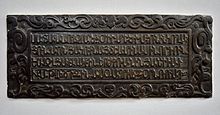Classical Armenian
| Classical Armenian | |
|---|---|
| Region | Armenian Highlands |
| Era | developed into Middle Armenian |
Indo-European
| |
Early form | |
| Armenian alphabet (Classical Armenian orthography) | |
| Language codes | |
| ISO 639-3 | xcl |
xcl | |
| Glottolog | clas1249 |
| Linguasphere | 57-AAA-aa |
 |
| History of the Armenian language |
|---|
|
|
Armenian alphabet Romanization of Armenian |

Classical Armenian (Armenian: գրաբար, grabar, Western Armenian krapar, meaning "literary [language]"; also Old Armenian or Liturgical Armenian) is the oldest attested form of the Armenian language. It was first written down at the beginning of the 5th century, and all Armenian literature from then through the 18th century is in Classical Armenian. Many ancient manuscripts originally written in Ancient Greek, Persian, Hebrew, Syriac and Latin survive only in Armenian translation.
Classical Armenian continues to be the liturgical language of the Armenian Apostolic Church and is often learned by Biblical, Intertestamental, and Patristic scholars dedicated to textual studies. Classical Armenian is also important for the reconstruction of the Proto-Indo-European language.
Phonology
Vowels
There are seven monophthongs:
- /a/ (ա), /i/ (ի), /ə/ or schwa (ը), /ɛ/ or open e (ե), /e/ or closed e (է), /o/ (ո), and /u/ (ու)(transcribed as a, i, ə, e, ē, o, and u respectively). The vowel transcribed u is spelled using the Armenian letters for ow (ու) but it is not actually a diphthong.
There are also traditionally six diphthongs:
- ay (այ), aw (աւ, later օ), ea (եա), ew (եւ), iw (իւ), oy (ոյ).
Consonants
In the following table is the Classical Armenian consonantal system. The stops and affricate consonants have, in addition to the more common voiced and unvoiced series, also a separate aspirated series, transcribed with the notation used for Ancient Greek rough breathing after the letter: p῾, t῾, c῾, č῾, k῾. Each phoneme has three symbols in the table. The leftmost indicates the pronunciation in International Phonetic Alphabet (IPA); in the middle is the corresponding symbol in the Armenian alphabet and the rightmost is its transliteration in the Latin alphabet (following the 1996 ISO 9985 standard).
| Labial | Alveolar | Palato-alveolar / Palatal |
Velar / Uvular |
Glottal | ||
|---|---|---|---|---|---|---|
| Nasals | /m/ մ m | /n/ ն n | ||||
| Stops | voiced | /b/ բ b | /d/ դ d | /ɡ/ գ g | ||
| unvoiced | /p/ պ p | /t/ տ t | /k/ կ k | |||
| aspirated | /pʰ/ փ p’ | /tʰ/ թ t’ | /kʰ/ ք k’ | |||
| Affricates | voiced | /dz/ ձ j | /dʒ/ ջ ǰ | |||
| unvoiced | /ts/ ծ ç | /tʃ/ ճ č̣ | ||||
| aspirated | /tsʰ/ ց c’ | /tʃʰ/ չ č | ||||
| Fricatives | voiced | /v/ վ v | /z/ զ z | /ʒ/ ժ ž | /ɫ/ ղ ł | |
| unvoiced | /f/ ֆ f | /s/ ս s | /ʃ/ շ š | /χ/ խ x | /h/ հ h | |
| Approximants | lateral | /l/ լ l | ||||
| central | /ɹ/ ր r | /j/ յ y | ||||
| Trill | /r/ ռ ṙ | |||||
The letter f (or ֆ) was introduced in the Medieval Period to represent the foreign sound /f/, the voiceless labiodental fricative; it was not originally a letter in the alphabet.[citation needed]
See also
Reference books
- Adjarian, Hrachia. (1971-9) Etymological Root Dictionary of the Armenian Language. Vol. I – IV. Yerevan: Yerevan State University.
- Meillet, Antoine. (1903) Esquisse d’une grammaire comparée de l’arménien classique.
- Thomson, Robert W. (1989) An Introduction to Classical Armenian. Caravan Books. (ISBN 0-88206-072-4)
- Robert Godel. "An Introduction to the Study of Classical Armenian". Wiesbaden: Dr. Ludwig Reichert Verlag, 1975
References
External links
- Classical Armenian Online (The University of Texas at Austin)
- New Dictionary of the Armenian Language (Nor Bargirk Haekazian Lezvi, Նոր Բառգիրք Հայկազեան Լեզուի), Venice 1836-1837. The seminal dictionary of Classical Armenian. Includes Armenian to Latin, and Armenian to Greek.
- Pocket Dictionary of the Armenian Language (Arrdzern Barraran Haekazian Lezvi, Առձեռն Բառարան Հայկազնեան Լեզուի), Venice 1865 (second edition).
- New Dictionary Armenian-English (Նոր Բառգիրք Հայ-Անգլիարէն), Venice, 1875-9.
- Grabar Dictionary (Գրաբարի Բառարան), Ruben Ghazarian, Yerevan, 2000.
- Grabar Thesaurus (Գրաբարի Հոմանիշների Բառարան), Ruben Ghazarian, Yerevan, 2006.
- A grammar, Armenian and English by Paschal Aucher and Lord Byron. Venice 1873
